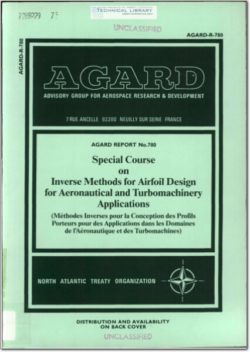AGARD-R-780

- Version
- 327 Downloads
- 103.98 MB File Size
- 1 File Count
- April 12, 2016 Create Date
- April 12, 2016 Last Updated
Inverse Methods for Airfoil Design for Aeronautical and Turbomachinery Applications

The demands for higher performance and a more flexible design system require the airfoil and turbomachinery blade designer
to be more innovative and to design beyond the limits of experimental data. Iterative procedures in which an optimum is
obtained by a comparison between the results of different designs are being replaced by new computational methods in which
the objective is defined by a direct calculation. Such methods use a minimum of empiricism. are better suited to profit from
modern computational tools. and are more easily integrated into modern manufacturing systems.
Blade or airfoil designs are normally made in two steps, and the lectures are accordingly grouped into two parts.
In the first part, optimisation of the target pressure and velocity distributions are discussed taking into account the required
performance and the loss mechanisms in the boundary layer. Both direct optimisation resulting from an inverse boundary layer
calculation. and an iterative optimisation by minimisation of the losses are presented. It is clear from both procedures that
inclusion of off-design operation is one of the greatest difficulties involved in blade or airfoil optimisation.
The second part of the course gives an overview of the numerous inverse blade design methods that have been developed both
for turbomachinery and aeronautical applications. This ranges from simple parameter definitions of two-dimensional cross-
sections to the full three-dimensional definition of wings and blade channels. The more academic interest of a detailed
numerical definition of arbitrary shapes conflicts here with the mechanical constraints imposed by the industrial manufacturer.
The methodology to account for a large number of constraints, as required in inverse designs and optimisations, is also
discussed and is illustrated by results from numerous applications discussed in the last group of lectures.
One of the objectives of this short course is to exchange views and to promote a discussion between turbomachinery and
aeronautical designers. Most designers are active only in one field of application and are not aware of publications by the other
group. However. boundary layer calculation methods. potential flow and Euler solvers are almost directly applicable to both
single blades and multiple blade rows. It is therefore surprising that this kind of discussion is not more frequent.
| File | Action |
|---|---|
| AGARD-R-780 Inverse Methods for Airfoil Design for Aeronautical and Turbomachinery Applications.pdf | Download |

Comment On This Post